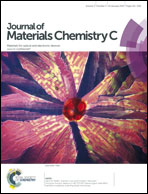Role of self-assembled tetraoctylammonium bromide on various conjugated polymers in polymer light-emitting diodes
Abstract
This study investigates the role of self-assembled tetraoctylammonium bromide (TOAB) on various conjugated polymers, namely green-emissive poly(9,9-dialkylfluorene) derivative (G-PF), super yellow poly(phenylenevinylene) (SY-PPV), and poly(3-hexylthiophene) (P3HT), in light-emitting devices based on these polymers. Atomic force microscopy images show that TOAB forms a homogeneous thin film with small grains on G-PF and SY-PPV, but forms an inhomogeneous film with large grains on P3HT. With TOAB deposited on these polymers, the emitting devices show better luminescence efficiency but lower current density compared to those of a Ca/Al cathode device. At a bias of 7 V, TOAB/Al-based devices have 1.67, 1.15, and 0.75 times the current density of the corresponding G-PF/Al-, SY-PPV/Al-, and P3HT/Al-based devices (159, 48, and 1233 mA cm−2), for which the hole injection barriers are 0.4, 0.1, and 0.0 eV, respectively. The increase in current density is attributed to the reduction of the electron injection barrier, which is due to the self-assembly of TOAB on the hydrophobic polymer surfaces for elevating the vacuum level by the interfacial dipole, as evidenced by synchrotron X-ray diffraction results. Of note, the ratio of the current density obtained for devices with and without TOAB decreases with decreasing hole injection barrier. The P3HT-based device shows a current density ratio of less than one (0.75), and thus has the highest light intensity (401 cd m−2) due to the hole blocking capability of TOAB.


 Please wait while we load your content...
Please wait while we load your content...